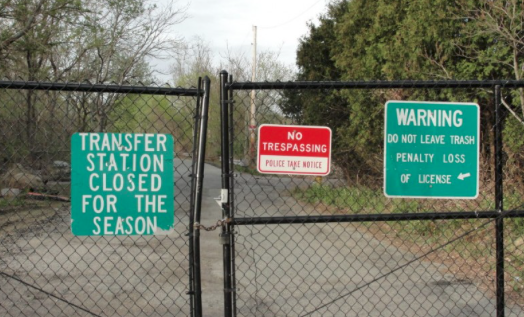Photo: The entrance to the former Belmont incinerator site.
Tick-tock, tick-tock.
With the clock now running on the future of the town’s former incinerator location near the Lexington/Belmont line, the Belmont Board of Selectmen will look to residents to supply some ideas on the site’s future.
“We will need to open it up to the public,” said Adam Dash, Selectmen’s chair. “All of them are clever and really good, but we can only do so much on that site.” Dash added he sees public meetings – much like those held last year on trash collection – sometime in June to gather resident input. The meeting will likely take place on June 9 at the Board’s first scheduled meeting at the conclusion of annual Town Meeting.
When the town took ownership of the site from the state 11 months ago – the deed for the property was transferred from the state on May 17, 2017 – the state required the town to construct a mitigation plan to remediate the site of contaminated soil and groundwater by “capping” the land polluted by ash produced in the burning of garbage. That work will need to be completed in the next few years.
The 16-acre property is located on upper Concord Avenue and the Rock Meadow Conservation about 1,500 feet from the Lexington town line. Opened in 1959, the incinerator operated until 1975, then becoming the town’s transfer station for decades before the state took control of the land. The Belmont Department of Public Works currently utilizes the site for equipment storage, leaf composting and the placement of debris.
As of fiscal 2016, Belmont had $3.5 million in a reserve account to clean the property.
Suggestions for future use include a dog park, solar farm, bike and recreation path, an expanded DPW operation, and even a marijuana farm. One use discussed in the past few months has been a new town skating rink.
At its last meeting, the selectmen and Town Administrator Patrice Garvin felt that before capping the site, a specific post-closure usage needs to be decided rather than moving immediately with full site remediation. What will be placed on the site will determine what type of cap is used; a passive recreational use will require a less intrusive barrier than one supporting a building.
“Because if you use all the money to cap it, you won’t have anything left if you want to do a recreational type of use,” said Garvin.
In the past month, Selectman Mark Paolillo said he and Garvin had met with Belmont Youth Hockey Association which is lining up funding for a proposed facility on the Belmont High School site, to ask if the skating rink “could work” on upper Concord Avenue.
“It does align with what we are doing at the High School site, so we have to start thinking about this sooner than later,” said Paolillo, who believes the rink could be located at the site, but legal matters remain on whether the facility would qualify as a municipal use which is allowed under the deed.








Leave a Review or Comment